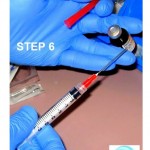 January 20, 2004 Mr. Marty Salanger Manager of Safety, Policy and Government Relations BD Advanced Protection Technologies 1 Becton Drive Franklin Lakes, NJ 07417 Dear Mr. Salanger: Thank you for your October 29, 2003 letter to the Occupational Safety and Health Administration’s (OSHA’s) Directorate of Enforcement Programs (DEP). This letter constitutes OSHA’s interpretation only of the requirements discussed and may not be applicable to any question(s) not delineated within your original correspondence. You had specific questions regarding an employer’s responsibility to re-evaluate engineering controls under OSHA’s bloodborne pathogens standard (29 CFR 1910.1030).
January 20, 2004 Mr. Marty Salanger Manager of Safety, Policy and Government Relations BD Advanced Protection Technologies 1 Becton Drive Franklin Lakes, NJ 07417 Dear Mr. Salanger: Thank you for your October 29, 2003 letter to the Occupational Safety and Health Administration’s (OSHA’s) Directorate of Enforcement Programs (DEP). This letter constitutes OSHA’s interpretation only of the requirements discussed and may not be applicable to any question(s) not delineated within your original correspondence. You had specific questions regarding an employer’s responsibility to re-evaluate engineering controls under OSHA’s bloodborne pathogens standard (29 CFR 1910.1030).
Your question is restated below followed by OSHA’s response. We apologize for the delay in responding. Question: If an employer has selected a particular safety-engineered device based on employee feedback, and a reduction in needlestick injuries can be shown as a result of the adoption of the current device, to what extent does an employer need to re-evaluate their chosen device?
Reply: As you are aware, OSHA’s bloodborne pathogens standard requires employers to review and update their Exposure Control Plan (ECP) at least annually [29 CFR 1910.1030(c)(1)(iv)]. It is also a requirement that: 1) annual reviews and updates of ECPs reflect changes in technology that eliminate or reduce exposure to bloodborne pathogens; and 2) employers document annually their consideration and implementation of appropriate commercially available and effective safer medical devices [29 CFR 1910.1030(c)(1)(iv)(A-B)]. If, after employee input, an employer selects an engineering control that is effective in reducing needlestick injuries, it is not necessary to evaluate all newly emerging engineering controls each year. The employer must simply keep abreast of new and emerging technologies and solicit input from non-managerial employees to determine if the facility’s chosen device remains preferable to any newly developed products. This should be documented in the ECP. Since the requirements of the standard are performance-based, OSHA determines compliance with the standard on a facility-by-facility, instance-by-instance basis, based on the employer’s consideration of safer medical devices, solicitation of input from employees, documentation in an employer’s ECP, and employee interviews.
Thank you for your interest in occupational safety and health. We hope you find this information helpful. OSHA requirements are set by statute, standards, and regulations. Our interpretation letters explain these requirements and how they apply to particular circumstances, but they cannot create additional employer obligations. This letter constitutes OSHA’s interpretation of the requirements discussed. Note that our enforcement guidance may be affected by changes to OSHA rules. Also, from time to time we update our guidance in response to new information. To keep apprised of such developments, you can consult OSHA’s website at http://www.osha.gov . If you have any further questions, please feel free to contact the Office of Health Enforcement at (202) 693-2190. Sincerely, Richard E. Fairfax, Director Directorate of Enforcement Programs —————————————————– ~ www.QDSS.co ~ www.SafetySyringe.cc ~ Needlestick Injuries, Legislation and More…